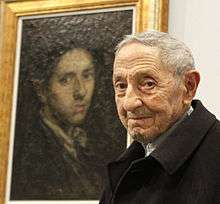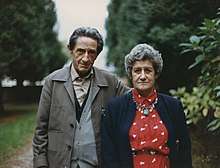Isaac Díaz Pardo
Isaac Díaz Pardo (August 22, 1920 – January 5, 2012) was a Galician intellectual strongly attached to both Sargadelos and Cerámica do Castro.

He was an intellectual galicianist, painter, ceramist, designer, editor and businessman.

He was born in Santiago de Compostela and died in A Coruña.[1][2]
In 2009, he received the Medalla de Oro al Mérito en las Bellas Artes (Gold Medal of Merit in Fine Arts) of Spain.
Isaac Díaz Pardo was the son of the painter and scenographer Camilo Díaz Baliño. Several reunions related to the League of Friends of the Galician Language took place in their house as Díaz Baliño was an active member. Other members who took part in these meetings include Castelao, Vicente Risco, Otero Pedrayo, Ramón Cabanillas, Antón Villar Ponte, Eduardo Blanco Amor and Asorey.
Sr. Díaz Pardo's father was shot by rebels soon after the beginning of the Spanish Civil War, forcing him into hiding in La Coruña where he stayed with his uncle Indalecio and found work as a letterer. After the war he received a bursary from the Provincial Government of La Coruña, thanks to which he was able to study at the Royal Academy of Fine Arts of San Fernando in Madrid, between 1939 and 1942.
He went on to take a professorship at The Catalan Royal Academy of Fine Arts of Saint George in Barcelona, and began to exhibit in Spain (La Coruña, Madrid and Vigo) and abroad (Europe and The Americas). He then left the plastic arts for ceramics, founding the Cerámicas do Castro factory with several partners. At this point he experimented with the raw materials used in original 19th Century works by Antonio Raimundo Ibáñez Llano y Valdés (notably from Sargadelos and Cervo). This resulted in ceramics of high quality.
In 1963 Isaac Díaz Pardo, alongside other prominent Galeguistas such as Luis Seoane, helped establish the experimental porcelain factory "Porcelanas de Magdalena", also known as Laboratorio de Formas. The factory was located in the village of Magdalena, Buenos Aires. This pioneering-venture was a precursor in several industrial and cultural activities, including the production and restoration of Sargadelos ceramics. Among their collaborators were Cerámicas do Castro (1963), el Museo Carlos Maside (1970), la editorial Ediciós do Castro (1963), el restaurado Seminario de Estudos Galegos (1970) and el Instituto Galego de Información. Sr. Díaz Pardo, formerly a prominent figure at Grupo Sargadelos, failed increasingly to see eye to eye with the directors and company administration at the moment of his retirement.
As an essay writer and critic, Sr. Díaz Pardo made notable contributions to Xente do meu Rueiro, O ángulo de pedra, Galicia Hoy (with Luis Seoane), Paco Pixiñas (with Celso Emilio Ferreiro), El Marqués de Sargadelos, and Castelao. Many more articles were published, for example in La Voz de Galicia.
References
- "Fallece el intelectual galleguista Isaac Díaz Pardo". ABC. EFE. January 5, 2012. Retrieved January 5, 2012.
- Isaac Díaz Pardo Staunch defender of Galician language, culture dies at 91
![]()